Happy Holidays
We put a lot of thought into everything we do here at Art Wolfe, Inc. Happy Holidays!
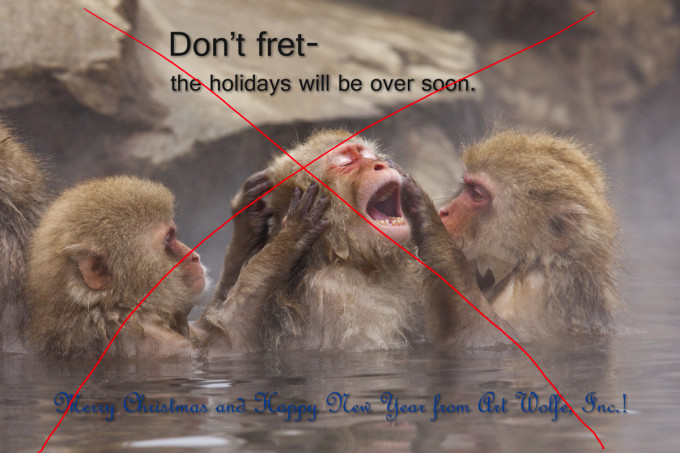
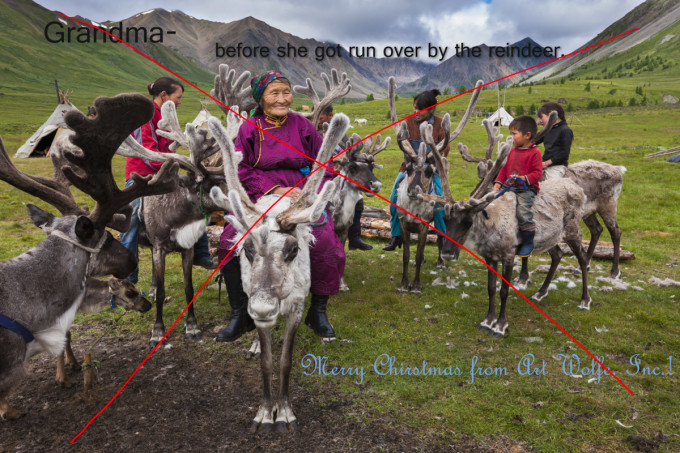
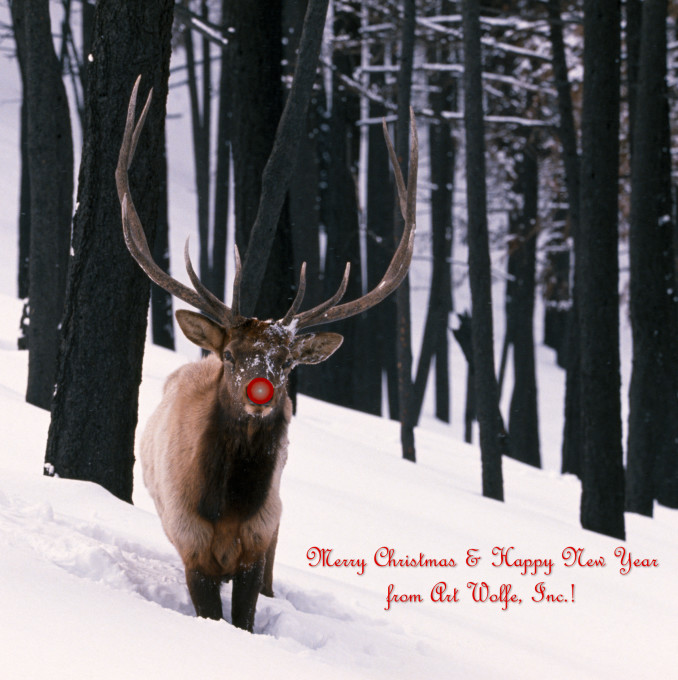
Creatively yours,
Art, Chris, Libby, Amanda, Tim, Bill & Deirdre

We put a lot of thought into everything we do here at Art Wolfe, Inc. Happy Holidays!



Creatively yours,
Art, Chris, Libby, Amanda, Tim, Bill & Deirdre

To call this trip an adventure is an understatement. In early December I traveled with several friends to the northern region of Ethiopia with Erta Ale volcano as the ultimate goal. Fellow traveler Michael Reichmann of Luminous Landscape was a wonderful travel companion and he has written a very good travelogue. Needless to say, we did not make it to the volcano for a variety of reasons. In forty years of photography I can count on one hand the number of times I have been sick or just plain stymied on a trip, so I count myself supremely lucky.

This all new seminar has been created for photographers who are inspired to go beyond capturing a natural history moment and would rather pursue their creativity and make compelling artistic statements.
In this three part series Art will establish unequivocally that the photograph stands toe to toe with painting, sculpture, and the other prominent forms of art.
This is an intentional journey to discover a new way of seeing and making art through the photographic medium. This full day seminar has been carefully crafted using hundreds of photographs that support the concepts Art is presenting.
Sign up before Jan 8th to get the early bird price of $200.
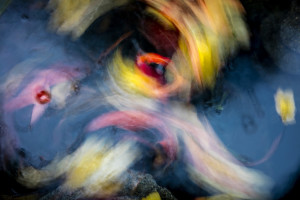
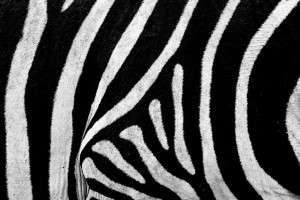



Holiday special for today only- we are adding a mystery free item to every order placed today!
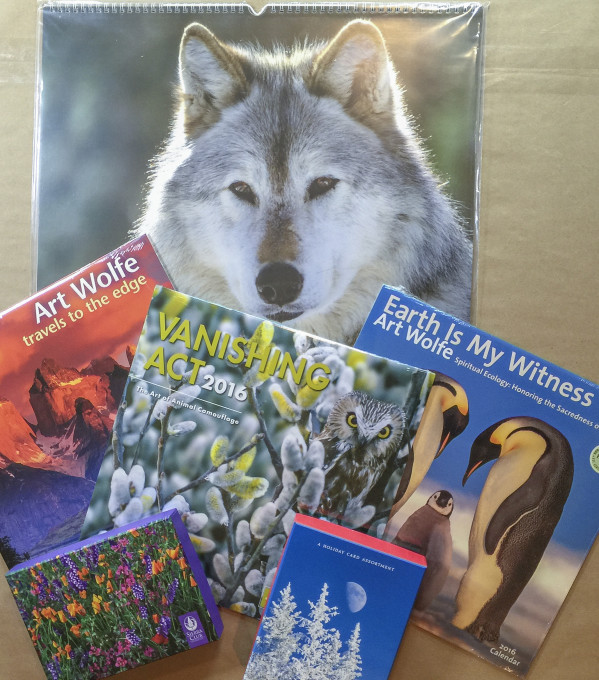


This is what we wait for every year. The new unveiling of the color that will dictate our lives for the coming months…
This time Pantone has selected an unprecedented two colors, Rose Quartz and Serenity, as an antidote to modern day stresses. When taken in moderation, they do have a very calming effect.

This story originally appeared on dpreview.com
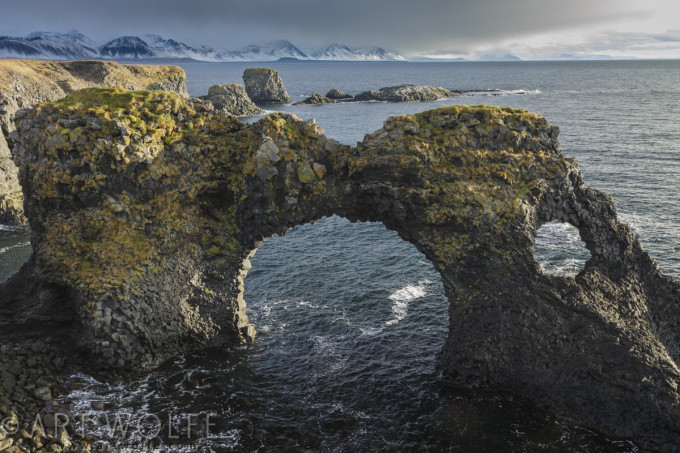
I have traveled to Iceland several times in my career to photograph the volcanic landscapes, the icebergs along glacier fed shores, even the diminutive and iconic Icelandic horses. It was on a trip in October 2013 however that I set out with the intention of capturing the aurora borealis or northern lights phenomenon — a spectacular sight I had seen before but never captured to my satisfaction. This was an ideal opportunity to observe them due to the long nights and the fact that we were at a peak in a 9-year cycle of solar activity responsible for generating auroras. Now, I just had to cross my fingers for a clear night and the ideal opportunity during my short, week-long stay.
So this story should be all about auroras however, as I have always said, you must remain open to opportunities that present themselves wherever you are. Don’t be blind to what is right in front of you simply because it’s not what you had planned to photograph when you had first set out. Seize every opportunity, don’t tell yourself “that looks great and I’ll come back and shoot it later”. Weather changes, winds pick up, clouds move, and schedules change. The best time to capture an image is when you first see it.

I was in route to a new location and it was an unusually calm morning. We were simply driving along the northern coast in Vesturland when I saw Mount Kirkjufell with a very light dusting of new snow near the summit which certainly wouldn’t last the day, perhaps not even through the afternoon. What immediately caught my attention was a huge eye staring back at me from out of its side. I had to practically rub my own eyes and look twice but there it was, plain as day, staring right at me. It immediately reminded me of the eye on a US dollar bill hovering above the pyramid. It was a little disturbing even. Had there been any less snow, it would not have been there at all and any more snow and it would have been covered up entirely. It was just that perfect dusting that revealed the eye in the mountain, always there, but rarely seen by passers-by.
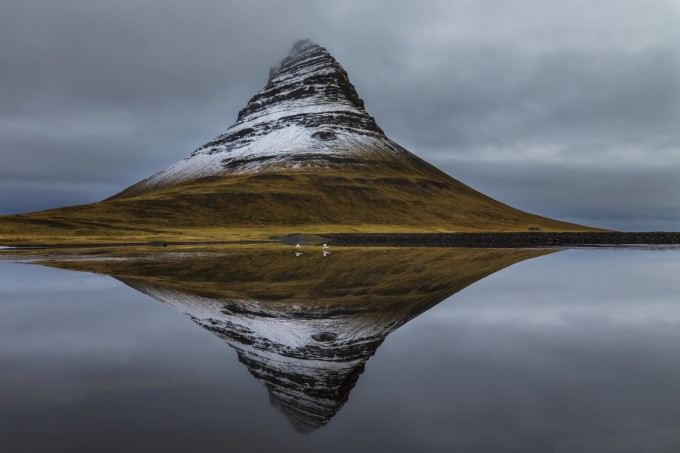
All of the elements coalesced that day for this shot. The beautiful symmetry of Mount Kirkjufell, a perfectly placid lake at the base to reflect the mountain and the eye, and then, as we stopped and pulled over to compose the shot, I could see two whooper swans up the lake sitting on the water. They would be too small to see in the final image so I chose not to include them in the composition so as not to distract, however as I stayed with the subject, moving my tripod, trying different exposures and angles they took flight moving from left to right down the lake. Seeing it unfold before me I panned the camera, framed the mountain and shot a sequence of images as the swans passed directly front and center.
Everything had to come together at that moment, entirely unplanned and unpredicted. I love these serendipitous moments. While I always have a plan when I go out to a location, sometimes orchestrating the shot, getting up before the sunrise or planning for a moonless night, working with interpreters and locals or using guides to help find specific animals, it’s these moments that can’t be anticipated, can’t be planned for, that I love and am always on the lookout for.

And that wasn’t the last time a serendipitous moment that would fall into my lap on this trip.
The following day I came across a nice young couple in Southern Iceland and we struck up an instant conversation comparing notes on the landscape and what the other had discovered. It turns out they were professional climbing guides who were more than happy to show me some of the less accessible areas of Iceland on and even under the glaciers. Well I wasn’t going to pass up that opportunity. No, I hadn’t come to Iceland for glacier photography nor did I even bring the basic equipment from my own climbing days – it simply wasn’t on the agenda. However, I found myself, later that same afternoon, meeting up with this young couple again and donning borrowed crampons, an ice axe and roping gear and we set out racing the sun late in the day to investigate an ice cave they had told me they had found high up on a glacier.
Practically racing up the glacier was only the beginning as I would soon learn. Once on location we had to rappel down directly into the glacier where a stream had melted out a shallow tunnel beneath the thick ice above. How they discovered this I still don’t quite know as we had to crawl on our hands and knees for over 200 hundred yards under the glacier. “What would drive them to do this in the first place?” I kept asking myself. We were crawling in wet gravel, crossing the stream from time to time, always bent over or on hands and knees, clothes and boots getting increasingly wet with each foot forward, and I was freezing trying to keep hold of my tripod and constantly bumping my backpack into the ice immediately above me.
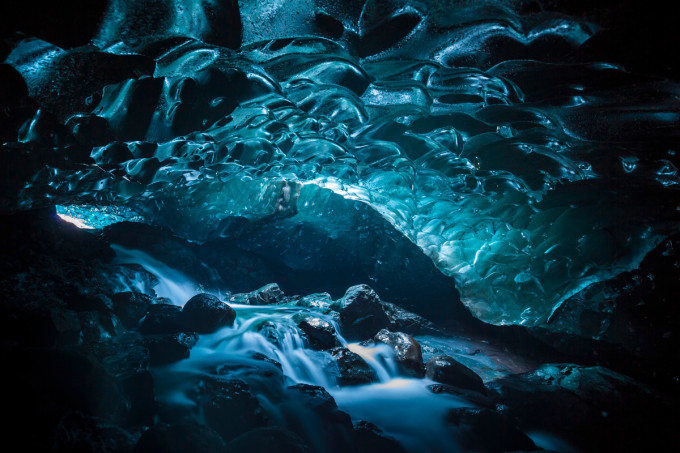
As promised there was an eventual payoff 200 feet below the surface of the glacier. A crevasse had bottomed out on the stream we were following providing a source of light to illuminate this cavern which they had discovered. It was a spectacular scene and I only had about 20 minutes of light to quickly size it up. I choose a wide-angle lens and exposures started at one minute and only grew from there as I worked fast in the fading light. I love the jade blue cast to the entire scene and the movement in the water. The elements all came together to provide an unworldly scene unlike any other ice cave I have photographed before.
With headlamps, we retraced our route crawling back through the ice cold water and gravel. Prior to leaving for Iceland and even that very morning, for that matter, I had no idea I’d be crawling around underneath a glacier in such conditions. At the very least I would have packed some warmer clothes, heavier rain gear and even knee pads for the trek. I am very aggressive and seeing an opportunity like this, knowing that wind and water can reveal beautiful patterns in the ice beneath snow fields and glaciers, I wasn’t about to pass it up simply because it wasn’t part of what I had planned or imagined when I had set out.
Now did I ever get around to shooting the auroras? Absolutely! Though it was only on the very last day of the week on this long trip that the clouds parted and revealed the dancing colors in the skies over the glacial Lake Jökulsárlón on the edge of Vatnajökull National Park. Every night leading up to that last day was clouded over and I had begun to accept that photographing the auroras, the only reason I had initially set out for Iceland, simply wasn’t going to happen on this trip.
Taking one last chance I waited until 1 a.m. and despite earlier clouds that evening, eventually the lights came out and the stars shone, it was like magic. It is a joyous moment as a photographer when you guess right and your effort is rewarded, and even more so sometimes when you take a risk and seize an opportunity.
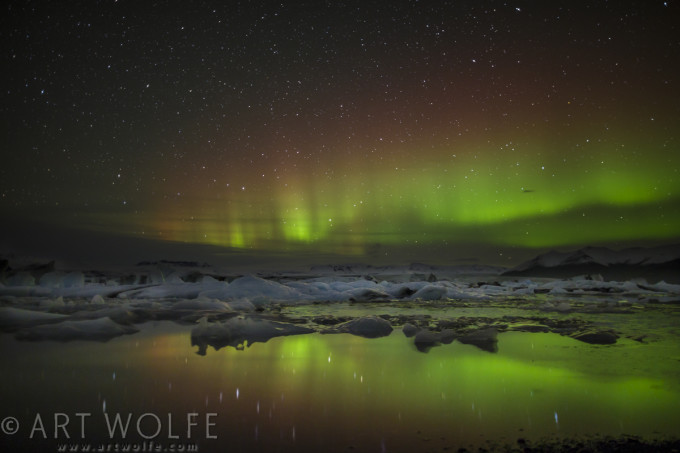
I love it when it all comes together like it did for this trip to Iceland.

The cheetah is the world’s fastest land animal and Africa’s most endangered cat. Uniquely adapted for speed, the cheetah is capable of reaching speeds greater than 110 kilometers per hour in just over 3 seconds, and at top speed their stride is 7 meters long. With its long legs and very slender body, the cheetah is quite different from all other cats and is the only member of its genus, Acinonyx. The cheetah’s unique morphology and physiology allow it to attain the extreme speeds for which it’s famous, and is often referred to as the greyhound of cats.
To find out more about this amazing cat visit internationalcheetahday.com


The season is upon us to reflect and give thanks. Rising at 4am, I photographed this tree on the shore of Japan’s tranquil Lake Biwa.
Save 20% on any Ki (木) print purchased this month. They are printed on EPSON Premium Photo Luster paper using archival EPSON Ultrachrome inks, and I hand sign them with a silver acid-free pen. Get more information about my Fine Art prints here.
